#flossy carter
Explore tagged Tumblr posts
Text
A Lesser-Known Modernism Inspired by African-American Culture
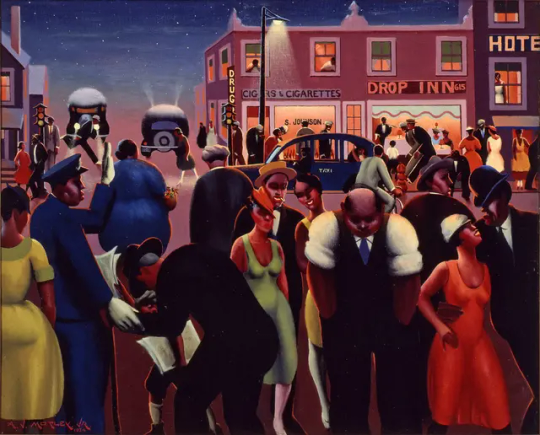
The Whitney Museum of American Art is presenting the career retrospective “Archibald Motley: Jazz Age Modernist,” which includes “Black Belt” (1934).Credit... Hampton University Museum, Hampton, Virginia, Valerie Gerrard Browne
By Holland Cotter Oct. 1, 2015
I don’t know how museums plot their seasons, but it was a good plan to have “Archibald Motley: Jazz Age Modernist” be the first career retrospective to appear at the Whitney Museum of American Art’s new home. Motley is an important but still understudied figure. The show itself is neither large nor hot off-the-shelf. (It originated at the Nasher Museum of Art at Duke University and has been traveling; this is the last stop.) But it has features that many bigger, sexier exhibitions lack: an affecting narrative, a distinctive atmosphere and a complicated political and moral tenor. It’s a tight, rich package. You take it away with you, complete.
And part of what you take away is an alternative version of the American modernism on which the Whitney is based. This other modernism developed outside of New York. It didn’t adopt abstraction as its defining advance style. It absorbed what was happening in Europe, but found its main power source in American culture, and specifically African-American culture. Archibald J. Motley Jr. — he used his full name professionally — was a primary player in this other tradition.
He was born in New Orleans in 1891 and three years later moved with his family to Chicago, which would become his permanent home. His African-born paternal grandmother, a former slave, came with them. There his father, a child of slaves, found work as a Pullman porter. His mother, of mixed racial descent, ran the house. When Motley’s teenage sister, Flossie, had a child, Willard, out of wedlock, the family raised him to believe that his mother and his uncle were his older siblings.
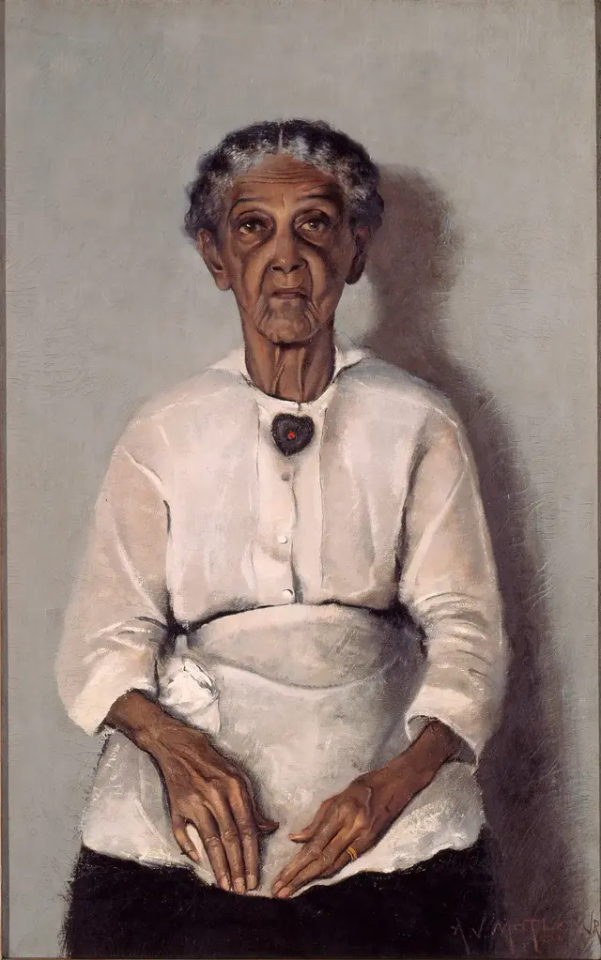
“Portrait of My Grandmother” (1922). Credit... Collection of Mara Motley, MD, and Valerie Gerrard Browne

“Portrait of Mrs. A.J. Motley, Jr.,” from 1930. Credit... Collection of Mara Motley, MD, and Valerie Gerrard Browne
Altogether, it was a household in which traditionally fixed categories of race and lineage were somewhat fluid. So was its relationship to class. The Motleys lived outside the so-called Black Belt of Chicago, the strictly demarcated African-American area also referred to as Bronzeville, on the city’s South Side. Their home was in a largely white immigrant neighborhood. Motley was one of the few black students at the School of the Art Institute of Chicago, where he received classical, European-based training as a painter. He married a white woman, Edith Granzo, his high school sweetheart.
Calibration of racial and social status by color is an underlying theme in the early portraits that open the exhibition, organized by Richard J. Powell, an art historian at Duke, and Carter E. Foster of the Whitney. Motley believed that information about the biology of race was important for both whites and blacks to have in the interest of mutual understanding.
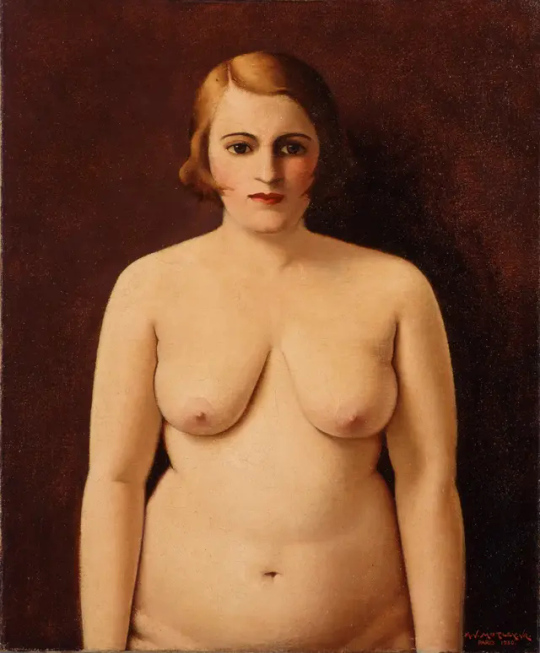
“Nude (Portrait of My Wife)" (1930). Credit... Collection of Mara Motley, MD, and Valerie Gerrard Browne
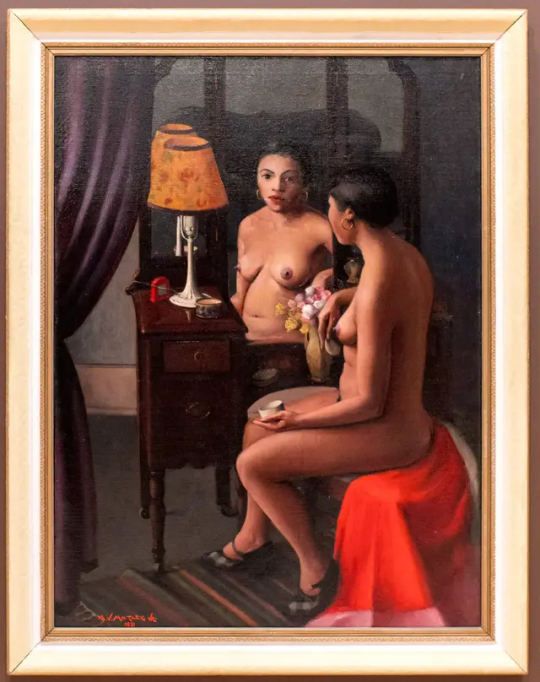
“Brown Girl After the Bath” (1931). Credit... Emon Hassan for The New York Times
In a 1924 picture, a dark-skinned older women dressed in a gingham dress and head scarf is identified as “Mammy.” A painting done a year later of a lighter-skinned young woman in a chic flapper cap is titled “The Octoroon Girl,” using a term once applied to someone with one-eighth black ancestry. In a 1930 nude portrait, Motley’s wife stands erect, arms down, face forward, glowing gold, as if posed for an epidermal inspection. A year later, in a more relaxed painting called “Brown Girl After Bath,” the glow remains, but gold has been exchanged for copper.
These images surround Motley’s own 1933 “Self-Portrait (Myself at Work),” which, ethnically speaking, gives little away. Dressed in a smock and beret, the artist, who by then had spent a year in Paris, looks neither distinctly black nor white, just seriously Continental. A neo-Classical statuette stands on his worktable. A crucifix hangs on the wall. (Motley was a practicing Roman Catholic.) He holds a big palette in one hand and conjures a nude model, Pygmalion-style, with his brush. He was at this point already nearing the peak of his professional success. The historian and activist W. E. B. Du Bois had publicly called him “a credit to the race,” though there is little of an obvious race man in the image here.

“Self-Portrait (Myself at Work)" (1933). Credit... Collection of Mara Motley, MD, and Valerie Gerrard Browne
This doesn’t mean that he kept himself at a remove from black popular culture. His deep but controlled immersion in it — wading in, stepping back — is what the exhibition as a whole is about. From an early age he had been a regular visitor to the Black Belt entertainment strip of jazz clubs, theaters, cafes and gambling joints known as the Stroll. And a section of the exhibition called “Nights in Bronzeville” is a record, in paintings, of his time spent there. If his portraits are an effort to capture and codify variations in racial appearance, his Bronzeville scenes, and their Paris equivalents, which he produced from the late 1920s onward, are attempts to find visual correlatives for the sounds of black music and colloquial black speech.
“Saturday Night,” from 1935, is a club scene. It takes what Motley learned about figure painting, color and composition, pushes that through an Expressionist filter, and sets it to a sinuous, thumping jazz score. The room is soaked in vermilion light. The band is far in the background, but its rhythms pulse through in the body of a single dancer who sways between the tables.
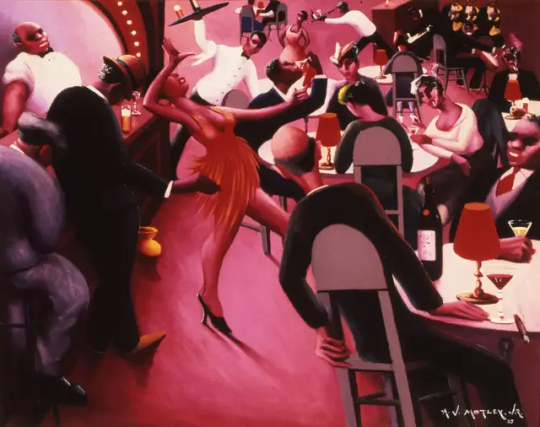
“Saturday Night” (1935).Credit...Howard University Gallery of Art, Washington, DC. Valerie Gerrard Browne
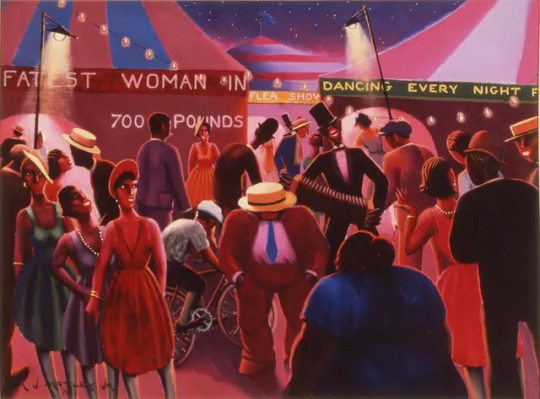
“Carnival” (1937).Credit...Howard University Gallery of Art, Washington, DC. Valerie Gerrard Browne
The same energy fills the night in “Carnival” from 1937, only now the music comes, outdoors, from an accordion-playing minstrel-show figure regaling a crowd of fairgoers. The smartly dressed visitors chat and preen. Stars shine overhead. A fat man in a straw skimmer, looking oddly isolated, moves through the center of the scene.
That man, or his equivalent, shows up in many of Motley’s city pictures. He’s an outrageous racial caricature: round-faced, popeyed, thick-lipped, a cartoon. Mr. Powell, in the catalog, pegs him as Motley’s alter ego, his way of acknowledging a feeling of distance from blackness but also an investment so thorough as to allow him to play with it, mess with it from the inside, as well as from the outside, pre-emptively expressing the racist hostility that is an unabating condition of American life. It’s a tactic used by writers like Zora Neale Hurston in Motley’s time, and in our own by comedians like Richard Pryor and artists like Robert Colescott and Kara Walker.
Motley continued to explore this risky mode of depicting social realities for the rest of his career which, gradually, went into decline. After his wife’s death in 1948, he made extended trips to Mexico, where his nephew Willard, a successful novelist, lived. Back in Chicago, to support his mother, who had remarried after his father’s death, he took a job with a company designing shower curtains. In 1955, he was jailed for six months for assaulting her abusive husband. In 1963, in his 70s, he began his last painting.
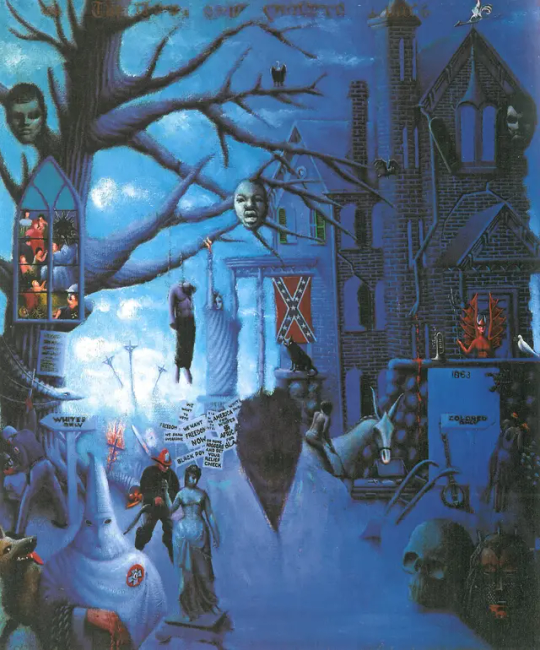
“The First One Hundred Years,” finished in 1972, was Archibald Motley’s final painting, and with its sweepingly topical content, it’s like no other picture he ever made. Credit... Collection of Mara Motley, MD, and Valerie Gerrard Browne
With its epic-length title — “The First One Hundred Years: He Amongst You Who Is Without Sin Shall Cast the First Stone; Forgive Them Father for They Know Not What They Do” — and sweepingly topical content, it’s like no other picture he ever made. Set in a twilight blue space, it has the mood of a composite-style nightmare to which new elements were added over time: an African mask paired with a human skull; a devil’s head and a peace dove; a Ku Klux Klan figure and the Statue of Liberty, and a “coloreds only” sign; a lynching and a crucifixion. And dead center is a man’s head in the format of a bust-length portrait, with the face blacked out.
This painting, hung on a wall by itself, ends the show, just as Motley’s confident 1933 studio self-portrait began it. When he finished “The First One Hundred Years” in 1972, he put his brushes down and painted nothing more in the remaining nine years of his life. His work ends in profound political anger and in unambiguous identification with African-American history. I would say that, behind his gracious portraits and his later, radical, jazz-scored scenes of black urban life, those feelings were in some measure ever-present. They help explain his art’s unforgettably puzzling texture and its surprising weight.
“Archibald Motley: Jazz Age Modernist” runs through Jan. 17 at the Whitney Museum of American Art; 212-570-3600, whitney.org.
7 notes
·
View notes
Text
HOMELATESTCULTUREENTERTAINMENTBEAUTY/STYLEAWARDS SEASON 2023
AWARDS SEASON 2023
Oscars 2023 Snubs: The Woman King Gets Shut Out Completely and The Academy Ought To Be Ashamed
Directors Ryan Coogler and Gina Prince-Byethwood were also noticeably absent.
By
Shanelle Genai
Published2 hours ago
Comments (4)
Alerts
We may earn a commission from links on this page.
While there were many expected recognitions during the 2023 Oscar nominations reveal on Tuesday (looking at you Angela Bassett, Ruth Carter, Rihanna and Brian Tyree Henry), there were also a plethora of stunning upsets—chief among them, the lack of recognition for The Woman King.
Watch
-1:20CC
Spike Lee Needed More Than Tea After Green Book Won the Oscar for Best Picture
Director Malcolm D. Lee on Breaking Out of the Limiting Label of 'Urban' Films
November 12, 2018
Something From Tiffany's Star, Kendrick Sampson, Plays That's So Random
December 22, 2022
In a shocking turn of events, there was not one single award nomination given to anyone from the Gina Prince-Bythewood-helmed film. Viola Davis, who is usually a shoe-in during awards season,saw no love in the Best Actress category despite previous nominations at the Golden Globes, SAG, NAACP Image, and AAFCA Awards. The whole squad of stellar supporting actresses and actors like Lashana Lynch, Thuso Mbedu, Sheila Atim, Adrienne Warren and John Boyega were also shut out. This is a frustrating trend that’s been popping up time and time again this awards season. Prince-Bythewood was also nowhere to be found in the Best Director category which honestly begs the question: did we all watch the same movie?
Related Stories
The Black Winners of Award Shows in 2023 [Update]
Spike Lee Needed More Than Tea After Green Book Won the Oscar for Best Picture
Girls Trip 2 is ‘Officially Happening.’ But Do We Need the Whole ‘Flossy Posse’ Back?
Personally, I find it hard to believe and somewhat offensive that a story as rich, layered, and historically complex as The Woman King was shut out in its entirety. Cries against its glamourization of the intra-racial participation in the slave trade aside (because if you actually watched the film and didn’t let the opinions of detractors online stop you, you would’ve seen that they actually addressed this), the film encompassed so much dimension and intricate storytelling it feels like a puzzling miss for the Academy—even given it’s history of snubs. And if we’re to say that that the sanitization of atrocities or historical inaccuracies of a fictional film warrant non-support from viewers, then I hope we’re ready to apply this across the board to other white projects that have been inspired by moments in history that fall short of holistically depicting what actuallyhappened. (Titanic anyone?)
ADVERTISEMENT
What’s also not lost on me is that this is a film starring deeply melanated Black women that’s centered around their plight, both communally and personally. This is also a central point to the Danielle Deadwyler-led film Till, which takes a turn away from the expected depictions of Black trauma and instead refocuses on humanizing a Black mother in her quest for justice for her slain son. Hollywood has notoriously categorized films starring Black folks about Black folks as “hard to sell” both domestically and abroad despite the success of projects like Black Panther and others proving otherwise. But I suppose involuted films centering Black women were a bit too deep or too uninteresting for viewers and the Academy this year.
And while we’re on the subject of snubs, I’d be remiss not to mention Ryan Coogler, who was also noticeably absent in the Best Director category (which is astonishing when you consider everything he and the cast had to deal with just to bring the long-awaited sequel to fruition.) Additionally, neither Black Panther: Wakanda Forever nor The Woman King received Oscar noms for Best Picture, though the latter did take home a win for that category at this year’s AAFCA Awards.
G/O Media may get a commission
20% OFF
W&P Valentine's Day Sale
Share the love Take 20% off sitewide at W&P, because sharing and prepping food is romantic af.
Buy at W&P
ADVERTISEMENT
I guess I shouldn’t be surprised, but I can’t help but to be. Blame it on the movie-lover in me, blame it on the “rooting for everybody Black” in me. But ultimately, we should blame it on the Academy because these are some hella interesting misses on their part and for that—they ought to be ashamed.
If Black News matters to you, then we belong in your inbox
Sign me up
By subscribing you agree to our Terms of Use and Privacy Policy.
You May Also Like
Sent from my iPhone
1 note
·
View note
Text

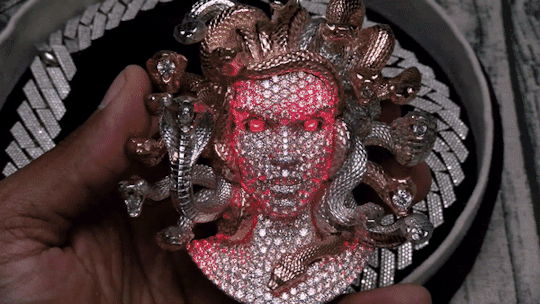

custom piece done by TraxNYC for Flossy Carter
#my gifs#custom jewelry#flossy carter#traxnyc#medusa#luxury#jewelry#diamonds#gold#colors#withbellzon
3 notes
·
View notes
Video
youtube
If it were up to me, my next pair of headphones would be some kind of cheaper AirPods Max---but while I wait for that product to actually exist, these just jumped to the top of my shortlist.
#Flossy Carter#Sennheiser Momentum 4 - Better Than The Sony WH-1000XM5's?#Headphones#Sennheiser#Sennheiser Momentum 4#YouTube
1 note
·
View note
Text
HOW TO BECOME A TECH INFLUENCER
HOW TO BECOME A TECH INFLUENCER
My man Flossie caught a big time in the text faced with reviewing products yo. What’s up, everybody should boy floss back again with another article and today we’re going to do a quick unboxing of the iPad pro the beach studio. 3, the Samsung Galaxy S 10. You know if you want to get in the tech space. This is a guy. You have to go through Flossie.

https://m.youtube.com/watch?v=U2kQgQ4CJh8
Do me a…
View On WordPress
#business#achievement#computer#content creator#content curator#Drop gems#entrepreneur#flossy carter#flossy carter s10#happiness#Inspiration#inspirational#Make Power Moves#marketing#motivational speaker#Power Moves#Prez#Prezidential#public speaker#Shawn Prez#success#tech influencers#technology#youtube
0 notes
Text
i have muse for some of my muses more than others at the moment. some of their information is listed below — like this for a short starter from one of them, please specify if you can or i will choose randomly.
alix carter (courtney eaton fc) / 25 / demisexual / horror movie writer daniella pérez (cierra ramirez fc) / 25 / bisexual / ethical hacker eden philips (sydney sweeney fc) / 22 / pansexual / shop assistant fallon perkins (olivia scott welch fc) / 23 / bisexual / movie set designer flossie wu (jessie mei li fc) / 24 / bisexual / graphic designer hera morias (barbie ferriera fc) / 24 / bisexual / diner waitress julián calag (evan mock fc) / 24 / bisexual / bartender and wannabe musician mirren moore (kaylee bryant fc) / 24 / bisexual / medical student monica bianchi (natasha liu bordizzo fc) / 26 / bisexual / hotel... everything noemi flores (zion moreno fc) / 26 / bisexual / apprentice tattoo artist oliver vanderbilt (alex fitzalan fc) / 24 / bisexual / unemployed sam harrington (nick robinson fc) / 24 / bisexual / microbiology student vesper murphy (laura harrier fc) / 30 / bisexual / emergency dispatcher
8 notes
·
View notes
Text


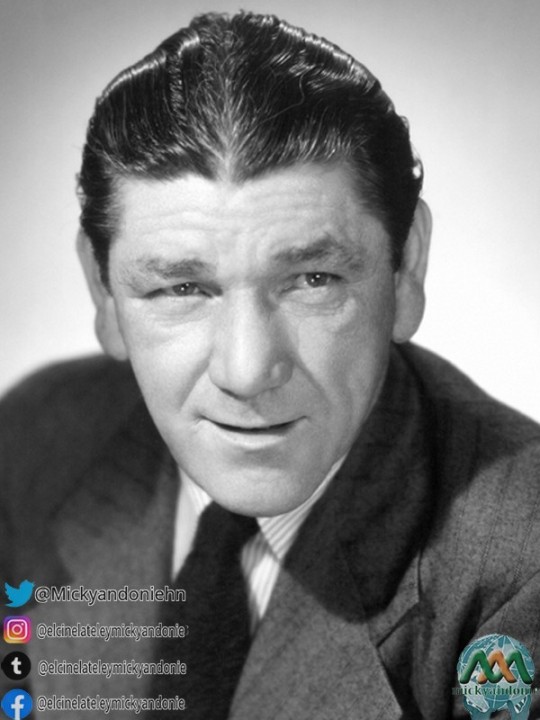

SHEMP HOWARD.
Filmography
Feature films, shorts and TV
1929: Fox Movietone Newsreel (himself)
1930: Soup to Nuts (firefighter)
1933: Salt Water Daffy (Wilbur, a kleptomaniac)
1933: Close Relations (cousin Mole)
1933: Paul Revere Jr. (stable boy)
1933; Gobs of Fun (nightclub client)
1933: In the Dough (Bug)
1933: Here Comes Flossie (Ezry)
1934: How'd Ya Like That? (sailor)
1934: Henry the Ache (Artie, one of King Henry's lackeys)
1934: The Wrong Wrong Trail (patient)
1934: Mushrooms (Thorndyke)
1934: The Knife of the Party (Shemp, leader of the Stooges)
1934: Everybody Likes Music (Shemp)
1934: Pugs and Kisses (Dopey Traynor)
1934: Very Close Veins (frozen drunk)
1934: Pure Feud (Clem McCarthy)
1934: Corn on the Cop (Reginald, tramp)
1934: I Scream (Moran's henchman)
1934: Rambling 'Round Radio Row # 7 (Series 2 # 1) (songwriter representative)
1934: Art Trouble (Shemp, art student)
1934: My Mummy's Arms (Kenneth)
1934: Daredevil O'Dare (circus promoter)
1934: Smoked Hams (Henry Howard)
1934: So You Won't T-T-T-Talk (Henry)
1934: Dizzy and Daffy (Lefty Howard)
1934: A Peach of a Pair (Shemp Butler)
1935: His First Flame (Smokey Moe)
1935: Convention Girl (Dan Higgins)
1935: Why Pay Rent? (Henry)
1935: Serves You Right (Johnny Spivens)
1935: On the Wagon (Henry)
1935: The Officer's Mess (Gus Doaks)
1936: While the Cat's Away (Henry)
1936: For the Love of Pete (Knobby Walsh)
1936: Absorbing Junior (Henry, husband)
1936: Here's Howe (Knobby Walsh)
1936: Punch and Beauty (Knobby Walsh)
1936: The Choke's on You (Knobby Walsh)
1936: The Blonde Bomber (Knobby Walsh)
1937: Kick Me Again (Knobby Walsh)
1937: Taking the Count (Knobby Walsh)
1937: Hollywood Round-Up (Oscar Bush)
1937: Headin 'East (Windy Wylie)
1938: Not Guilty Enough (Andy Clyde's brother-in-law)
1938: Home on the Rage (Andy Clyde's brother-in-law)
1939: Behind Prison Gates (inmate in charge of serving the mess hall)
1939: Another Thin Man (Wacky)
1939: The Glove Slingers (Uncle Pat Patrick, boxing manager)
1940: Money Squawks (Shemp)
1940: The Lone Wolf Meets a Lady (Joe, a pickpocket)
1940: Boobs in the Woods (Gus)
1940: Millionaires in Prison (Teacher)
1940: Pleased to Mitt You (Pat Patrick)
1940: The Leather Pushers (Sailor McNeill)
1940: The Bank Dick (Joe Guelpe, bartender)
1940: Murder Over New York (Shorty McCoy, the Carnarsie Kid)
1940: Give Us Wings (Buzz)
1940: The Invisible Woman (Hammerhead Frankie)
1941: Lucky Devils (pickpocket)
1941: Six Lessons from Madame La Zonga (Gabby)
1941: Buck Privates (cook)
1941: Meet the Chump (Stinky Fink)
1941: Road Show (Moe Parker)
1941: Mr. Dynamite (Abdullah)
1941: The Flame of New Orleans (waiter at the Oyster Bed Cafe)
1941: News of the Day Vol. 12 # 272 (client)
1941: Too Many Blondes (Ambrose Tripp, hotelier)
1941: In the Navy (Dizzy)
1941: Tight Shoes (Okay)
1941: San Antonio Rose (Benny the Bounce)
1941: Hit the Road (Dingbat)
1941: Cracked Nuts (Eddie / Ivan)
1941: Hold That Ghost (drinks and ice cream dispenser)
1941: Appointment for Love (man on the street)
1941: Hoosier Boy Makes Good (prop)
1941: Hellzapoppin '(Louie)
1942 Butch Minds the Baby (Squinty Sweeny)
1942 - Mississippi Gambler (Milton Davis, taxi driver)
1942: The Strange Case of Dr. Rx (Detective Sergeant Sweeney)
1942: Private Buckaroo (Sergeant Muggsy Snavel)
1942: Strictly in the Groove (Pops)
1942 - Pittsburgh (Shorty, the tailor)
1942: Arabian Nights (Sinbad)
1943: How's About It? (Alf)
1943: It Ain't Hay (Umbrella Sam)
1943: Keep 'Em Slugging (Binky)
1943: Crazy House (Mumbo)
1944: 3 of a Kind (Shemp Howard)
1944: Pick a Peck of Plumbers (Elmer)
1944: Moonlight and Cactus (Punchy Carter)
1944: Strange Affair (laundry driver)
1944: Open Season for Saps (Woodcock Q. Strinker)
1944: Crazy Knights (Shemp Howard)
1945: Off Again, on Again (suicidal boyfriend)
1945: Trouble Chasers (Shemp Howard)
1945: Where the Pest Begins (Shemp Howard)
1945: A Hit with a Miss (Rameses, boxer)
1946: The Gentleman Misbehaves (Marty)
1946: Mr. Noisy (Noisy, the annoying spectator)
1946: Jiggers, My Wife (Woodcock 'Woody' J. Strinker)
1946: One Exciting Week (Marvin Lewis)
1946: Dangerous Business (Monk)
1946: Society Mugs (Shemp)
1946: Blondie Knows Best (Jim Gray)
1947: Bride and Gloom (Shemp)
9 notes
·
View notes
Video
Figgers F3 - The Best Deal In Wireless! I have to pass it around! Have to give credit when credit is due! To both Flossy Carter review and Figgers F3 product!
3 notes
·
View notes
Text
iPhone status symbol politics explained in < 30 seconds
#my uploads#iphone 13 pro max#iphone 12 pro max#flossy carter#iphones#technology#comedy#real talk#lol#nyc#queens#iphone 13#withbellzon
13 notes
·
View notes
Video
youtube
Might have to blow my budget and give one of these a try.
0 notes
Video
youtube
Technics AZ70 True Wireless Noise Canceling Earbuds
2 notes
·
View notes
Video
youtube
All The New Skullcandy True Wireless Earbuds
2 notes
·
View notes
Video
youtube
Samsung Galaxy Z Fold 2 5G - Unboxing and First Impressions
1 note
·
View note
Video
youtube
Samsung Galaxy Note 20 Ultra 5G - Unboxing and First Impressions
1 note
·
View note
Video
youtube
Samsung Galaxy Tab S7 Plus - Unboxing and First Impressions
1 note
·
View note
Video
youtube
All The New JBL Truly Wireless Earbuds
1 note
·
View note